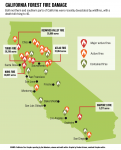Campus Queries is a series in which Daily Bruin readers and staff present science-related questions for UCLA professors and experts to answer.
Q: Why have this year’s wildfires across California been more destructive in loss of property and human life compared with other years?
More than a dozen fires spread throughout Northern California last week, resulting in 42 casualties, making it one of the deadliest fires in California’s history. The fires are predicted to cost nearly $65 billion in property damages.
A: The rapid spread of fires in both the northern and southern areas of California are due to dry vegetation providing an ignition source and powerful winds blowing from high pressure areas in the east to the low pressure areas in the west, said Jon Keeley, an adjunct professor of ecology and evolutionary biology.
“These winds have a velocity of up to 50 to 60 miles per hour and we’ve just had a 4 to 6 month long drought,” he said. “This combination is the reason the fires can be so uncontrollable.”
However, Keeley said human activity, such as population growth and urban planning, plays a major role in the fire’s destruction.
For example, the Tubbs fire, which has so far spread through roughly 36 thousand acres and claimed 15 lives in Napa and Sonoma counties as of Thursday, burned through a similar pathway as the Hanley fire in 1964. The Hanley fire burned through roughly 50 thousand acres and 84 homes, but no lives were lost because the area was much less populated and developed at the time, Keeley said.
“We need better urban planning to avoid putting people in the path of these destructive fires,” he said.
Keeley said the vast majority of fires in California’s coastal areas start from human activity like fallen power lines and arson. He said he thinks to prevent future fires, there should be more underground power lines, strict arson prevention and better urban planning.
“Power companies were initially not fond of the idea (of more underground power lines) because it was more expensive,” he added. “But after this event, they may be less reluctant.”
Keeley said his research found a correlation between rising temperatures and fire severity in mountainous regions of California. However, rising temperatures have not affected fire severity along coastal areas because temperatures in those areas have historically already been high enough to cause large fires, he added.
